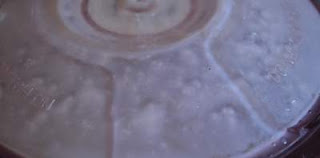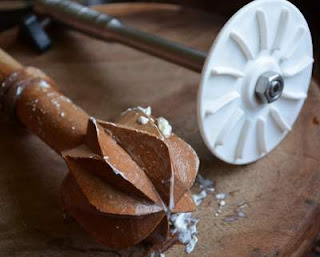 |
| Curdled cream |
You will note a change in sound of whipping/blending and note butter particles sticking to the lid of blender. Turn off the blender and check to see butter floating on top of buttermilk.
 |
| Fat particles seen in the lid |
 |
| Butter floating on buttermilk |
If butter appears as dispersed particles, pour into a non-reactive container and gently stir or whisk with a spoon till butter particles begin to fuse together. With a spoon or clean hand, form a single mass.
Separate butter from buttermilk. Add normal/cold water into the container with butter and gently mix with a spoon or clean fingers, discard water. repeat till the butter no longer gives out buttermilk or water remains clear when butter is washed.
 |
| Butter after 3rd wash |
 |
| Buttermilk |
Traditionally, butter was (is) extracted using a wooden churner.
 |
| Traditionally churned butter |
 |
| Traditional wooden churner(L) Modern metallic churner(R) |
Note:
You can also make butter by collecting cream collected at the top of yogurt (if you have not skimmed off the layer after boiling), or blend full fat yogurt.
Traditional homes in India store butter in earthen pots kept suspended by ropes from the ceiling.
Normally butter is extracted fresh early every morning from home made yogurt. In places where refrigeration is not available, the low temperatures early in the morning, helps in easy extraction of butter.
To preserve butter without refrigeration: It has to be stored in a container filled with water (till butter floats) and kept covered. Change water every day.
Butter extracted from buffalo milk is white in colour and that from cow milk is yellowish in colour.

No comments:
Post a Comment